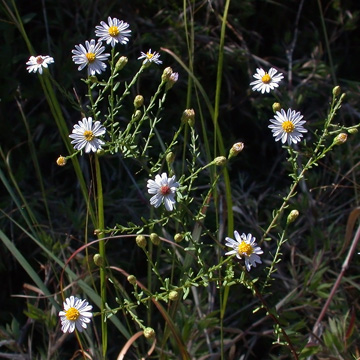

Symphyotrichum dumosum - (image 1 of 5)
Taxonomy
Family: Asteraceae
Habitat
Dry or moist, often sandy places.
Associates
Distribution
Southern ME to FL, west to MI, AR, and LA. Most common on or near the Atlantic coastal plain.
Morphology
Herbaceous perennial; stems 30-100 cm; leaves linear to lance-linear or linear-elliptic, sessile, more or less entire, often scabrous above and glabrous beneath, chiefly cauline, leaves of the branches much reduced; inflorescence open, often diffuse; head usually numerous, long-pedunculate, the peduncles with numerous spreading or ascending, oblong or spatulate bracts and some of them 2 cm up to 15 cm; involucre glabrous, its bracts strongly imbricate, obtuse or dilated near the short broad green tip; rays 13-30, pale bluish or lavender, sometimes white, 5-9 mm; lobes of the disk corollas comprising 20-35% of the limb.
Notes
Flowers August to October
Wetland Indicator: NA
The long peduncles with numerous bracts help distinguish this species from other similar small-flowered white(ish) asters. Symphyotrichum racemosum is similar but has smaller heads produced in greater numbers that tend to turn upwards.
References
Gleason, Henry A. and A. Cronquist. 1991. Manual of Vascular Plants of Northeastern United States and Adjacent Canada. Second Ed.
The New York Botanical Garden. Bronx, NY
|
© Michael Hough 2018 |